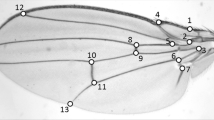Abstract
Using wild-reared flies, we examined sexual selection on five phenotypic traits (thorax length, wing length, wing width, head width, and face width) inDrosophila buzzatii, by scoring copulatory status in nine mass mating cages. Only male face width was identified as a direct target of sexual selection in an analysis of selection gradient, while indirect selection was present on all other studied traits, as expected from their correlations with face width. In contrast to males, there was no indication of selection in females. Nor was there evidence of assortative mating. The suggested direct selection on face width seems to take place during licking behavior of the courtship and might be related to courtship feeding. This study suggests that courtship success gives rise to indirect selection on body size.
Similar content being viewed by others
References
Cowley, D. E., and Atchley, W. R. (1988). Quantitative genetics ofDrosophila melanogaster. 11. Heritabilities and genetic correlations between sexes for head and thorax traits.Genetics 119 421–433.
Cowley, D. E., and Atchley, W. R. (1990). Development and quantitative genetics of correlation structure among body parts ofDrosophila melanogaster.Am. Nat. 135 242–268.
Endler, J. A. (1986).Natural Selection in the Wild, Princeton University Press, Princeton, NJ.
Ewing, A. W. (1961). Body size and courtship behaviour inDrosophila melanogaster.Anim. Behav. 9 93–99.
Ewing, A. W. (1964). The influence of wing area on the courtship behaviour ofDrosophila melanogaster.Anim. Behav. 12 316–320.
Fontdevila, A., Ruiz, A., Alonso, G., and Ocaña, J. (1982). The evolutionary history ofDrosophila buzzatii. 11. How much has chromosomal polymorphism changed in colonization.Evolution 36 843–851.
Hasson, E., Vilardi, J. C., Naveira, H., Fanara, J. J., Rodriguez, C., Reig, O. A., and Fontdevila, A. (1991). The evolutionary history ofDrosophila buzzatii. XVL. Fitness component analysis in an original natural population from Argentina.J. Evol. Biol. 4 209–225.
Hasson, E., Fanara, J. J., Rodriguez, C., Vilardi, J., Reig, O., and Fontdevila, A. (1993). The evolutionary history ofDrosophila buzzatii. Thorax length is positively correlated with longevity in a natural population from Argentina.Genetica 92 61–65.
Hocking, R. R. (1976). The analysis and selection of variables in linear regression.Biometrics 32 1–49.
Lande, R., and Arnold, S. J. (1983). The measurement of selection on correlated characters.Evolution 37 1210–1226.
Mitchell-Olds, T., and Shaw, R. G. (1987). Regression analysis of natural selection: Statistical inference and biological interpretation.Evolution 41 1149–1161.
Partridge, L., and Farquhar, M. (1981). Sexual activity reduces lifespan of male fruitflies.Nature (Lond.) 294 580–582.
Partridge, L., and Farquhar, M. (1983). Lifetime mating success of male fruitflies (Drosophila melanogaster) is related to their size.Anim. Behav. 31 871–877.
Partridge, L., Hoffman, A., and Jones, J. S. (1987a). Male size and mating success inDrosophila melanogaster andDrosophila pseudoobscura under field conditions.Anim. Behav. 35 468–476.
Partridge, L., Ewing, A., and Chandler, A. (1987b). Male size and mating success inDrosophila melanogaster: The roles of male and female behaviour.Anim. Behav. 35 555–562.
Roig, E., Ruiz, A., and Fontdevila, A. (1986). Análisis comparativo del comportamiento de apareamiento de las especies deDrosophila del clusterbuzzatii. XXII Jornadas de Genética Luxo-Españolas, Oviedo, Spain.
Santos, M., Ruiz, A., Barbadilla, A., Quezada-Diaz, J. E., Hasson, E., and Fontdevila, A. (1988). The evolutionary history ofDrosophila buzzatii. XIV. Large flies mate more often in nature.Heredity 61 255–262.
Santos, M., Ruiz, A., Quezada-Diaz, J. E., Barbadilla, A., and Fontdevila, A. (1992). The evolutionary history ofDrosophila buzzatii. XX. Positive phenotypic covariance between field adult fitness component and body size.J. Evol. Biol. 5 403–422.
Starmer, W. T., Peris, F., and Fontdevila, A. (1988). The transmission of yeast byDrosophila buzzatii during courtship and mating.Anim. Behav. 36 1691–1695.
Steele, R. H. (1986a). Courtship feeding inDrosophila subobscura. 1. The nutritional significance of courtship feeding.Anim. Behav. 34 1087–1098.
Steele, R. H. (1986b). Courtship feeding inDrosophila subobscura. 11. Courtship feeding by males influences female mate choice.Anim. Behav. 34 1099–1108.
Taylor, C. E., and Kekic, V. (1988). Sexual selection in a natural population ofDrosophila melanogaster.Evolution 42 197–199.
Wilkinson, G. S. (1987). Equilibrium analysis of sexual selection inDrosophila melanogaster.Evolution 41 11–21.
Wade, M. J., and Kalisz, S. (1990). The causes of natural selection.Evolution 44 1947–1955.
Author information
Authors and Affiliations
Rights and permissions
About this article
Cite this article
Norry, F.M., Vilardi, J.C., Fanara, J.J. et al. Courtship success and multivariate analysis of sexual selection on morphometric traits inDrosophila buzzatii (Diptera: Drosophilidae). J Insect Behav 8, 219–229 (1994). https://doi.org/10.1007/BF01988906
Accepted:
Issue Date:
DOI: https://doi.org/10.1007/BF01988906




